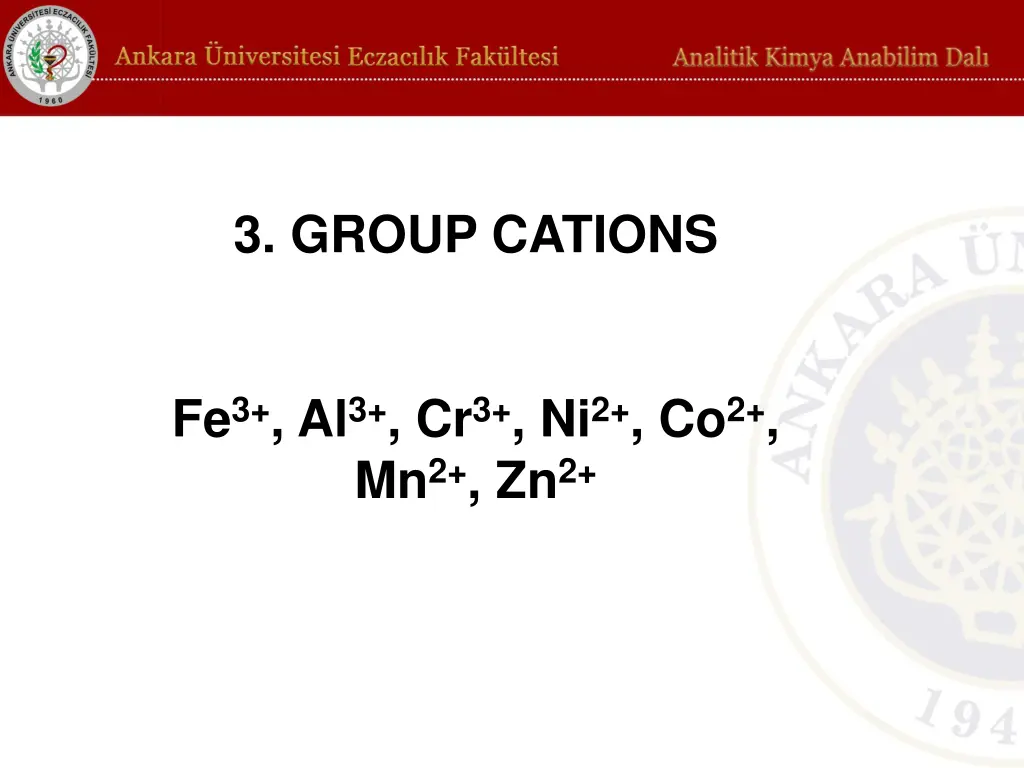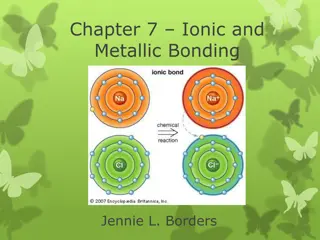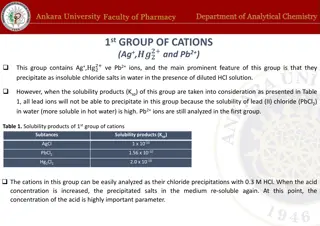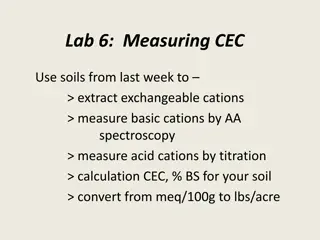
Systematic Analysis of Group III Cations in Chemical Precipitation Reactions
Learn about the systematic analysis of Group III cations (Fe3+, Al3+, Cr3+, Ni2+, Co2+, Mn2+, Zn2+) in chemical precipitation reactions using specific reagents and techniques. Understand how to differentiate and identify these cations based on their unique precipitates formed in the presence of different solutions.
Download Presentation

Please find below an Image/Link to download the presentation.
The content on the website is provided AS IS for your information and personal use only. It may not be sold, licensed, or shared on other websites without obtaining consent from the author. If you encounter any issues during the download, it is possible that the publisher has removed the file from their server.
You are allowed to download the files provided on this website for personal or commercial use, subject to the condition that they are used lawfully. All files are the property of their respective owners.
The content on the website is provided AS IS for your information and personal use only. It may not be sold, licensed, or shared on other websites without obtaining consent from the author.
E N D
Presentation Transcript
3. GROUP CATIONS Fe3+, Al3+, Cr3+, Ni2+, Co2+, Mn2+, Zn2+
These cations precipitate as sulfides and hydroxides when reacted with hydrogen sulfide (H2S) or thioacetamide solution in basic medium buffered with NH4OH NH4Cl. These cations do not precipitate with the reagents used for precipitation of the group I and II.cations. Group III cations are divided into two: 1) Iron Group (Group 3A): Fe3+, Al3+, Cr3+ (precipitates in the form of hydroxides). 2) Zinc Group (Group 3B): Ni2+, Co2+, Mn2+, Zn2+ (precipitates in the form of sulfides).
Systematic analysis of group III cations: 20 drops of sample containing Fe3+, Al3+, Cr3+, Ni2+, Co2+, Mn2+, Zn2+ taken into a tube from the sample. Add 10 drops of 4 M ammonium chloride (NH4Cl) solution and 10 drops of 2 M ammonium hydroxide (NH4OH, %33) solution dropwise to the sample and check the basicity of the solution with a litmus paper. Then add 20 drops of NH4OH solution and Fe3+, Al3+ and Cr3+ precipitate as their hydroxides. Heat the solution for 5 min at water bath and add 20 drops of thioacetamide solution (11%, w/v) and observe precipitates of sulfides of Ni2+, Co2+, Zn2+ and Mn2+ (COMMON PRECIPITATE) This precipitate contains Al(OH)3, Cr(OH)3, Fe(OH)3, NiS, CoS, MnS, and ZnS and it is washed several times with 0.1 M NH4Cl.
Precipitate A (CoS ve NiS): Precipitate A is taken into cruicible, heated on bunsen burber till the solute part evaporates if exist, and add 20 drops of aqua regia (15 drops of 6 M HCl + 5 drops of 6 M HNO3) to dissolve the precipitate. Add from NH4OH (%33) solution until it is basic (check with red litmus paper). Divide the solution into two parts. To the first part, add 10 drops of 0.1 M potassium ferricyanide (K4[Fe(CN)6]) solution and the dark green color is followed, which is the precipitate of cobalt ferricyanide (Co2[Fe(CN)6]). This shows the presence of Co+2. To the second part, add 2 drops of 6 M NaOH and 2 drops of dimethyl glyoxime (%1 in 96% alcohol), the rose color shows the presence of Ni+2.
Supernatant A (Fe3+, Al3+, Cr3+, Mn2+, Zn2+): Add 20 drops of 6 M NaOH and 20 drops of 3% H2O2 (v/v) are added to the supernatant. Centrifuge and separate supernatant B and the precipitate B. Transfer precipitate B to a clean test tube, add 10 drops of HNO3 (37.5%) and pinches of spatula sodium bismuthate (NaBiO3) from the side of the tube. The color of violet proves the presence of Mn2+. Add 0.1 M K4[Fe(CN)6]to the precipitate B, the prussian blue precipitate proves the presence of Fe3+.
Supernatant B (Zn2+, Al3+, Cr3+): Add 20 drops of HNO3 and NH4OH to the solution until it is basic. Centrifuge and separate the supernatant C and the precipitate C Precipitate C is white aluminum hydroxide (Al(OH)3). The yellow color of the supernatant C, which contains Cr3+ and Zn2+, indicates the presence of Cr3+. Add 20 drops of 2 M CH3COOH to the supernatant C to make the medium acidic. Add pinches of spatula of sodium acetate (NaCH3COO). Heat the solution in a water bath for 20 min and add 2 drops of 0.5 M barium chloride (BaCl2) solution to the hot solution. The formed yellow precipitate (precipitate D) is barium chromate (BaCrO4). Add 2 drops of thioacetamide solution (11% w/v) to the supernatant D and heat it up in the water bath with stirring for 5 minutes until the white precipitate is visible. The formation of dirty white zinc sulfide (ZnS) shows the presence of Zn2+.
III. GROUP CATIONS 20 drops of sample 10 drops of 4 M NH4Cl Dropwise 2 M NH4OH check the basicity of the solution with a litmus paper. 20 drops of NH4OH eklenir. Heat the solution for 5 min at water bath and add 20 drops of thioacetamide solution COMMON PRECIPITATE Al(OH)3, Cr(OH)3, Fe(OH)3, NiS, CoS, MnS, ZnS Wash several times with 0.1 M NH4Cl Add 20 drops of 6 M HCl Centrifuge and separate the supernatant A and the precipitate A. PRECIPITATE A: CoS, NiS SUPERNATANT A: (Fe3+, Al3+, Cr3+, Mn2+, Zn2+) aken into cruicible, heated on bunsen burber till the solute part evaporates 20 drops of aqua regia (15 drops of 6 M HCl + 5 drops of 6 M HNO3) to dissolve the precipitate. Add 2 M NH4OH check the basicity with red litmus paper. Divide the sample into two 20 drops of 6 M NaOH 20 drops of 3% H2O2 Centrifuge and separate supernatant B and the precipitate B. 2 drops of 6 M NaOH 2 drops of dimethyl glyoxime PRECIPITATE B Fe(OH)3, MnO2 SUPERNATANT B: Zn 10 drops of 0,1 M (K4[Fe(CN)6]) 20 add Centrifuge and separate the supernatant C and the precipitate C rose color Ni +2 dark green color Co +2 Divide the sample into two Add 0.1 M (K4[Fe(CN)6]) Transfer to a clean test tube 10 drops of HNO3 pinches of spatula sodium bismuthate (NaBiO3) from the side of the tube PRECIPITATE C prussian blue precipitate Fe3+ white aluminum hydroxide (Al(OH)3) Violet color, Mn2+ SUPERNATANT D 2 drops heat it up in the water bath with stirring for 5 minutes until the white
III. GROUP CATIONS 20 drops of sample 10 drops of 4 M NH4Cl Dropwise 2 M NH4OH check the basicity of the solution with a litmus paper. 20 drops of NH4OH eklenir. Heat the solution for 5 min at water bath and add 20 drops of thioacetamide solution COMMON PRECIPITATE Al(OH)3, Cr(OH)3, Fe(OH)3, NiS, CoS, MnS, ZnS Wash several times with 0.1 M NH4Cl Add 20 drops of 6 M HCl Centrifuge and separate the supernatant A and the precipitate A. SUPERNATANT A: (Fe3+, Al3+, Cr3+, Mn2+, Zn2+) 20 drops of 6 M NaOH 20 drops of 3% H2O2 Centrifuge and separate supernatant B and the precipitate B. PRECIPITATE B Fe(OH)3, MnO2 SUPERNATANT B: Zn2+, Al3+, Cr3+ 20 drops of HNO3 add NH4OH until it is basic. Centrifuge and separate the supernatant C and the precipitate C Divide the sample into two Add 0.1 M (K4[Fe(CN)6]) Transfer to a clean test tube 10 drops of HNO3 pinches of spatula sodium bismuthate (NaBiO3) from the side of the tube SUPERNATANT C: Cr3+, Zn2+ PRECIPITATE C prussian blue precipitate Fe3+ 20 drops 2 M CH3COOH pinches of spatula of sodium acetate (NaCH3COO) Heat the solution in a water bath for 20 min add 2 drops of 0.5 M barium chloride (BaCl2) solution to the hot solution. white aluminum hydroxide (Al(OH)3) Violet color, Mn2+ PRECIPITATE D SUPERNATANT D 2 drops of thioacetamide solution heat it up in the water bath with stirring for 5 minutes until the white precipitate is visible. Yellow precipitate barium chromate BaCrO4 dirty white precipitate ZnS
When excess NH3 is added to the starting solution, red brown color indicates the presence of the Fe3+, and/or colorless and gelatinous precipitate indicates the presence of Al3+.





















